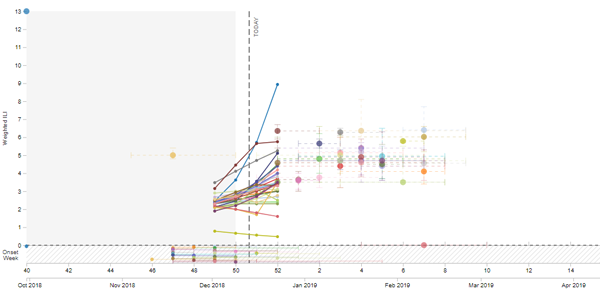FluSight: Flu Forecasting
Each week during the influenza season, CDC displays the forecasts received through the Epidemic Prediction Initiative (EPI). Forecasting for the 2019–2020 influenza season has ended. Forecasting for the 2020–2021 influenza season will resume later in 2020, pending developments with the ongoing COVID-19 pandemic.

The Influenza Division at CDC has engaged with members of the scientific community on real-world influenza forecasting challenges known as FluSight.

Flu forecasting offers the possibility to look into the future and better plan ahead, potentially reducing the impact of flu.

“FluSight,” flu forecasting website is part of CDC’s Epidemic Prediction Initiative. This website facilitates the real-time sharing and visualization of weekly flu forecasts.
CDC’s efforts with forecasting began in 2013 with the “Predict the Influenza Season Challenge”, a competition that encouraged outside academic and private industry researchers to forecast the timing, peak, and intensity of the flu season. Each influenza season since then, flu experts within the Influenza Division have worked with CDC’s Epidemic Prediction Initiative (EPI) and external researchers to advance flu forecasting. CDC provides forecasting teams data, relevant public health forecasting targets, and forecast accuracy metrics evaluated against actual flu activity while each team submits their forecasts based on a variety of methods and data sources each week. During the 2018–19 season, CDC expects forecasting teams to provide over 30 national-level forecasts each week.
Interested in participating in the challenge? Please email flucontest@cdc.gov for more information.
During the 2018-2019 flu season, 24 different teams participated in the flu forecasting initiative, each submitting 38 different weekly forecasts. Los Alamos National Laboratory, led by Dr. Dave Osthus, provided the most accurate national-, regional-, and state-level influenza-like illness forecasts. This marks the first influenza season during which forecasts from Dr. Osthus’ team have been the most accurate. The Delphi group at Carnegie Mellon University, led by Dr. Roni Rosenfeld, provided the most accurate national-level hospitalization forecasts. This marks the fifth season during which forecasts provided by Dr. Rosenfeld’s team have been the most accurate.

